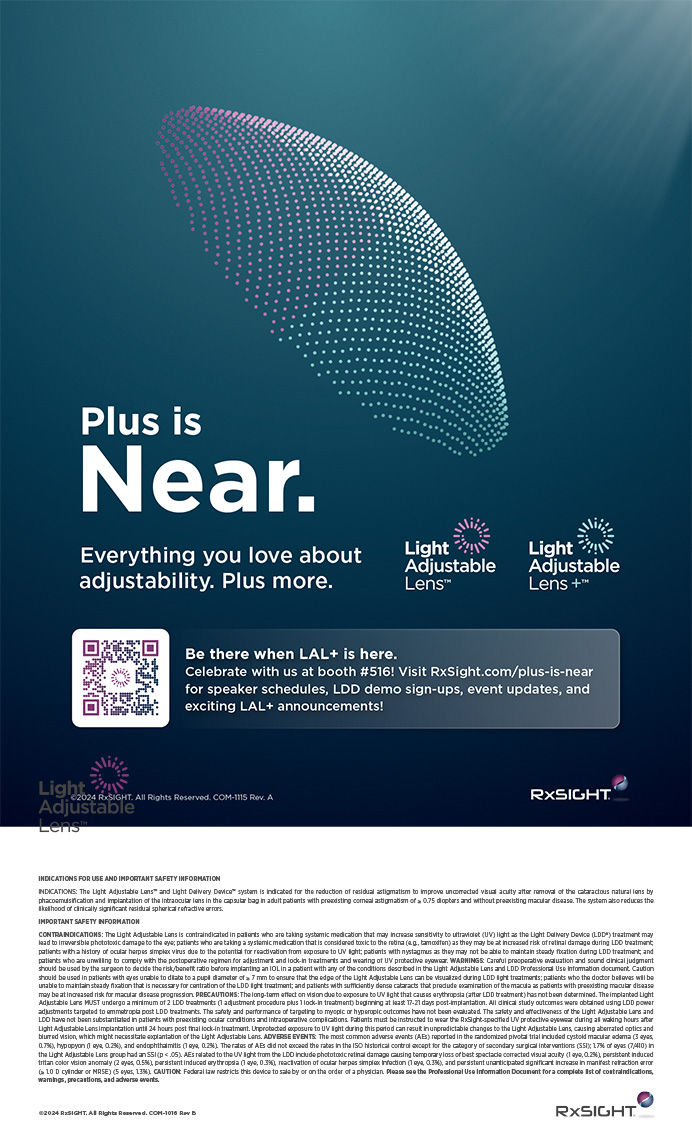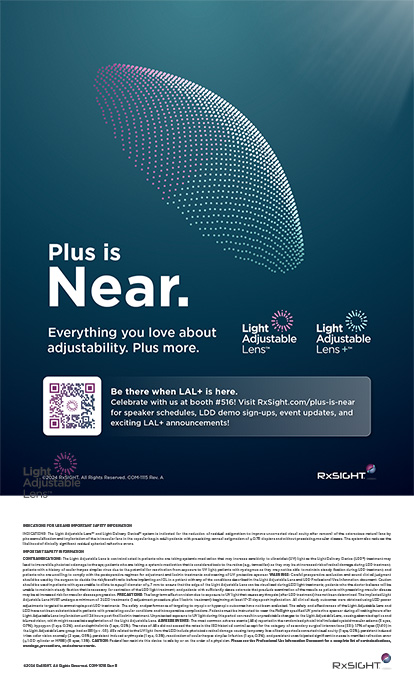Physician Extenders Are Ideal for Large, High-Volume Practices
Ophthalmologists cannot do it alone.
In the current era of ophthalmology, in which we strive to provide excellent patient care in an efficient manner, ophthalmologists cannot do it alone. It is no surprise, then, that many practices are successfully utilizing physician extenders to optimize patient care. Whether by using technicians and scribes to streamline clinic flow, engaging in collaborative comanagement with optometrists, or integrating physician assistants (PAs) and nurse practitioners (NPs) into the practice, there are many ways in which physician extenders can add value in ophthalmology.
AT A GLANCE
- Collaboration between ophthalmologists and optometrists can be mutually beneficial, facilitating continuity of care for patients and allowing surgeons to concentrate on surgery.
- Use of PAs and NPs has not been common in ophthalmology, although it is increasing.
- A barrier to the use of PAs and NPs has been the lack of specialty-specific training programs for these disciplines, but, with investment in adequate training, these programs can bring value to a practice.
CLINIC STAFF
We may often take for granted the steps our clinic staff members have already taken before a patient sits in our examination chair. Use of ophthalmic technicians is fairly standard in ophthalmology, and they contribute to the smooth running of our clinics. They can start the discussion with the patient regarding his or her chief complaint, perform the initial workup, and complete the myriad tests that may be required for the visit. As a result, by the time the patient sees the ophthalmologist, all necessary information is easily accessible, and a treatment decision can be made in a timely fashion.
Technicians can significantly affect productivity in an ophthalmology clinic and improve patient access to care by increasing the number of clinic visits and unique patients seen per year.1 The more skilled an ophthalmic technician is, the more we can rely on his or her preliminary workup, and the more efficient clinic flow becomes. Thus, it is to our advantage to hire competent, motivated employees who are enthusiastic to learn and to provide suitable training so that their levels of expertise meet our expectations.
Employing a scribe in a clinic to assist with charting and coding patient encounters can also help increase overall efficiency and optimize the number of patients seen on a daily basis. As with technicians, it is essential that scribes be appropriately trained in documenting pertinent examination findings and properly coding visits.
COLLABORATIVE COMANAGEMENT
As the baby boom generation ages and the demand for cataract surgery increases, ophthalmologists must be able to accommodate higher surgical volumes. Many practices have moved toward an integrated care model wherein optometrists and ophthalmologists work together to meet the demand for eye care.
Our practice uses a network of referring optometrists in satellite offices and in the greater community to provide primary eye care and comanage cataract surgery patients. In this model, optometrists continue their relationships with patients as their primary eye care providers. When the time comes for cataract surgery, the optometrist partners with us as a part of the surgical team, and we strive collectively for the best outcome for the patient. The optometrist then comanages the patient postoperatively and continues primary eye care thence forward. In this way, the ophthalmologist can focus on performing surgery while the optometrist continues the medical care of the patient.
In our practice, we have recently moved toward improving the patient experience one step further by offering same-day surgery to cataract patients. With an in-house optometrist working closely with the ophthalmologist, comanaged patients are examined the morning of their surgery with appropriate testing and counseling, followed by cataract surgery that same day. Patients, particularly those who travel substantial distances for care, greatly appreciate minimizing the number of trips to the clinic. They can then follow up with a local optometrist after uncomplicated surgery.
The collaboration between the ophthalmologist and optometrist is mutually beneficial. To ensure that optometrists understand the services we offer to patients, and to update them on the latest technology available, we host periodic continuing medical education seminars throughout the year for optometrists in the area.
Operating at a high-volume practice in which this model is central, we see definite advantages to collaborating with optometrists, in contrast with our experience in training at academic institutions that did not use a collaborative care model. Patients have continuity of care with their optometrists, and the ophthalmologist can focus on performing high-quality, high-volume surgery.
PAs AND NPs
Historically, PAs and NPs have not been widely used in ophthalmology. A barrier to this has been the lack of specialty-specific training in standard training programs for these disciplines. Without a doubt, any PA or NP incorporated into an ophthalmology practice will need appropriate ophthalmology-related training. Once sufficient time has been invested into ensuring adequate training, however, PAs and NPs can bring value to an ophthalmology practice.
PAs and NPs are ideal for large, high-volume practices, where their impact will be significant in increasing revenue for the practice. With their medical training, they can play a significant role in streamlining surgery by completing patients’ preoperative physical examinations, thus eliminating an additional trip to primary care physicians. Unlike most optometrists, depending on state regulations, they can also perform minor procedures, such as capsulotomy and laser peripheral iridotomy, and assist in surgery.
With appropriate training, PAs and NPs can enhance the flexibility of a practice by triaging and managing emergency or walk-in patients, allowing the practice to address the needs of these patients in a timely fashion. It has been shown in an emergency eye clinic that there is good concordance between ophthalmologists and NPs in terms of diagnosis and management.2 These providers can also perform primary eye care services and be involved in postoperative care.
PAs can also be assets in academic settings. During my residency training, I (KJ) benefitted from having a PA integrated into the ophthalmology consult service. The PA could directly care for patients in the emergency room and inpatients in the hospital. By virtue of the PA’s assistance with the call burden ordinarily taken by residents, I was able to enhance my residency education by spending more time in the clinic and OR. In my program, integration of the PA afforded each first-year resident nearly 28 more days per year to attend to other clinical assignments. This led to a 75% increase in total annual surgical volume for the first-year residents, with a median wait time for consults reduced by 29 minutes.3
LOOKING TO THE FUTURE
With the commercial availability of the Light Adjustable Lens (RxLAL, RxSight), we predict that PAs, NPs, and optometrists will be highly valuable physician extenders in the postoperative period. Once a patient with the RxLAL is healed from cataract surgery and the refraction is stable, up to three light treatments are possible postoperatively using the Light Delivery Device (RxSight) to adjust the power of the lens to the patient’s satisfaction, followed by up to two lock-in treatments.
This postoperative routine will require significantly more clinic visits than standard cataract surgery. At these visits, refractions and light treatments will be performed, along with assessments of appropriate near targets for monovision patients. Utilization of PAs, NPs, and optometrists in care for patients with the RxLAL will be essential in streamlining the postoperative period.
As the demand for ophthalmologists has increased, we have seen a growing trend in ophthalmology toward the use of physician extenders. Practices should strongly consider incorporating physician extenders to improve efficiency and quality of care for patients.
1. Lynch MG, Maa A, Delaune W, et al. Eye care productivity and access in the veterans affairs health care system. Mil Med. 2017;182(1):e1631-e1635.
2. Kirkwood BJ, Pesudovs K, Loh RS, et al. Implementation and evaluation of an ophthalmic nurse practitioner emergency eye clinic. Clin Exp Ophthalmol. 2005;33(6):593-597.
3. Lee B, D’Souza M, Singman EL, et al. Integration of a physician assistant into an ophthalmology consult service in an academic setting. Am J Ophthalmol. 2018;190;125-133.
Physician Extenders Make Far-Reaching Contributions
These health care practitioners can help to maximize the business opportunities within the practice.
I’ve been practicing as a PA at Williamson Cosmetic Center for 18 years. I joined the Williamson Eye Center practice specifically to offer nonsurgical cosmetic services. At that time, our primary physician was an ophthalmologist who performed cosmetic surgical procedures for the eyes and skin. Around that time, onabotulinumtoxinA injection (Botox Cosmetic, Allergan), devices for laser hair removal, and several dermal fillers began to receive FDA approvals, and the Williamson Eye Center decided it was a good time to create a separate entity that was solely devoted to cosmetic surgical and nonsurgical services, the Williamson Cosmetic Center & Perenack Aesthetic Surgery. Our practice staff includes two surgeons, two PAs, two NPs, nurses, aestheticians, and laser technicians (Figure).

Figure. The staff at Williamson Cosmetic Center & Perenack Aesthetic Surgery includes two surgeons, two PAs, two NPs, nurses, aestheticians, and laser technicians.
The idea of combining aesthetic medicine with an eye practice was new at that time, and the Williamson Cosmetic Center achieved early success, mostly related to having an advanced practice practitioner (APP) available to perform laser therapy and administer injectables.
The contributions a PA can make to a practice are far-reaching. The physician-surgeon can continue to do what he or she does best, while the PA grows the nonsurgical portion of the practice. This synergistic relationship not only builds the practice as a whole but also feeds the surgeon’s practice.
CLINICAL ROLES
PAs and NPs function in our practice in clinical roles. Usually an APP is the first contact new patients will have with our practice. We evaluate, diagnose, offer treatment suggestions, and perform the procedure. The APP is trained in the art and science of injectables such as onabotulinumtoxinA injection and the multiple hyaluronic acid fillers including Juvederm (Allergan) and Restylane (Galderma). Additionally, the APP can serve as a laser technician for laser tattoo removal, body contouring, and laser skin resurfacing.
Often, we refer patients to the surgeons if that is the best option. Our team approach tends to be the highlight of our practice. We have the ability to offer everything aesthetically, both surgical and nonsurgical. Patients leave knowing that we have recommended the best options for them.
CHANGING LANDSCAPE
In Louisiana, the landscape for hiring PAs has improved dramatically of late, as barriers have been removed. Before this past year, a practice could employ only two PAs per physician. Now, one physician can have up to eight PAs. PAs in Louisiana have full prescribing authority. Mandatory chart review by the physician has been eliminated and is now determined onsite. In Louisiana, a registered nurse can inject onabotulinumtoxinA as directed by a physician, although the law is limiting because the physician must be physically present when the service is performed. These changes have made PAs a valuable resource in medical practices in Louisiana.
Our APP injectors make us the No. 1 provider of onabotulinumtoxinA injection in Louisiana and put us among the top 100 practices in the country for the manufacturer. If we did not have our team of extenders, our ability to meet patient demand would be greatly limited, as our team of surgeons would have to treat all of the patients.
EDUCATING PATIENTS
Aesthetics is a relatively new category of medicine that does not really belong to one physician community or another. Traditionally, these services were offered by dermatologists and plastic surgeons, but, as this space has grown over 30 years, the number of providers who perform these services has also grown.
Patients often ask why a physician is not performing their treatment and whether I am qualified to do so. I love when someone asks me a question like this because it gives me an opportunity to educate the patient on what a PA does and to explain my education and training.
Our APP injectors are solely devoted to injectables, all day, every day. So the idea that a physician is the only person who should be injecting is just not true. What is true, however, is that the injector must have experience and must be qualified. In certain practices or regions this may be the physician, but more commonly it is a PA or NP.
Meeting the Needs of a Changing Field
Physician extenders can enhance the quality and even the scope of services delivered by ophthalmic practices.
The market for PAs across all specialties is booming, and ophthalmology will increasingly participate in this trend. The acute challenge in eye care today is the rapid aging of the population, set against the flat—and soon to be shrinking—number of ophthalmologists in active practice.
To meet the growing demand for services and to maintain market share, many practices will have to become creative in their deployment of resources. Declining rates of reimbursement will add further to this strain. Some practitioners may choose to work more hours than they already do, but, in this milieu, integration of PAs into ophthalmology makes practical sense—not only for their ability to be physician extenders, but also for their ability to enhance the quality and even the scope of services delivered.
SUPPORTING THE SURGEON
After 20 years of practice as a PA, all of it in ophthalmology, I can’t think of much that our physicians do clinically that I do not do. As a PA, my scope of practice involves anything that my supervising physician deems me capable of and proficient at doing (operating, of course, within guidelines set forth by the state medical board).
At Williamson Eye Center, this means that I function just as a general ophthalmologist does in clinic. One key difference, however, is that the slant of my medical practice is to help evaluate and aggressively refer all surgical candidates to our surgeons for consultation. That is, I am unlikely to simply monitor a patient with a borderline cataract or a patient with marginally controlled glaucoma on medications. Rather, I am likely to refer patients such as these for evaluation by the surgeon. Thus, I am supporting the surgical and the clinical sides of the practice.
Speaking of surgery, it should be noted that some PAs in ophthalmology assist in surgery and perform minor outpatient surgical procedures. This is true for both cataract and retina surgeries.
PERISURGICAL CARE
One particular area of the contribution of PAs to a busy refractive surgery practice is in pre- and postoperative care. Leveraging our medical training as generalists, PAs often perform history and physicals for surgery patients and for those who need Nd:YAG or other laser treatment. In a high-volume practice, this represents a lot of people.
Additionally, a PA’s activity not only serves the mandate of obtaining medical clearance for surgery, but it also represents a significant revenue stream for the clinic, as we are able to bill for these services. Postoperative care by PAs helps lighten the surgeon’s clinic load and adds another layer of contact that helps to increase patient compliance and improve outcomes.
Outside the clinic, my other duties include taking call, performing hospital consults, and presiding over educational programs for technicians.
THE CATCH
All good, right? But there is a catch. At the outset of a PA’s work in a specialty medical practice, there is a protracted learning curve. This is because PAs do not have the benefit of a formal residency—in other words, they are learning on the job.
Still, there are many activities that PAs will be able to perform relatively quickly with little or no training. This all depends on what the particular practice wants from the PA. For Williamson Eye Center, we want a producer in clinic who can cover the gamut and feed our surgery practice at the same time.
FELLOWSHIPS IN THE FUTURE?
For now, ophthalmology represents only a small fraction among the medical specialties that employ PAs. This, however, is likely to change. In the future, I envision schools or practices offering a postgraduate fellowship in ophthalmology for newly minted PAs.
Somebody has to fill the growing gap in access to quality eye care, and PAs have the potential to do so. I believe busy surgery practices have to look ahead. In the immortal words of the late, great Dr. John, “You got to roll with it, or you gonna roll under it.”








